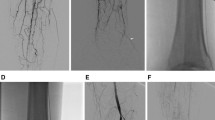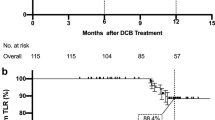Abstract
Introduction
Endovascular therapies have not yet had an ideal effect on thromboangiitis obliterans (TAO) and no data have been published about laser-assisted angioplasty (LA) combined with radiofrequency ablation (RFA) for TAO. This study aimed to investigate the outcome of LA combined with RFA for TAO.
Methods
Sixteen consecutive patients underwent LA and RFA procedures between June 2018 and March 2019 in this prospective pilot study. The clinical outcomes and complications were assessed at 6, 12, and 18 months after the procedure. The primary endpoint was defined as the limb salvage rate and freedom of target-lesion revascularization (f-TLR) of the limb, and the effect on the outcome was assessed by the ankle brachial index (ABI), numerical rating scores (NRSs), and the EuroQol Group 5-Dimension Self-Report Questionnaire (EQ-5D).
Results
Men accounted for 87.5% of the patients. All patients underwent LA, and following the RFA procedure, two patients received bailout stenting (12.50%). The technique success rate was 100%, and no severe complications occurred. The ABI was significantly higher at the 18-month follow-up than at baseline (P < 0.001). The primary and secondary patency rates were 71.82% and 79.80%, respectively, and the f-TLR and limb salvage rates were 90% and 92.86% based on Kaplan–Meier analysis. The EQ-5D value was higher after the procedure than at baseline (P < 0.001), and the NRS value was lower after the procedure than at baseline (P < 0.001).
Conclusions
Our results confirmed that LA combined with RFA was a feasible procedure that resulted in acceptable limb salvage and f-TLR rates.



Similar content being viewed by others
References
Buerger L. Thrombo-angiitis obliterans: a study of the vascular lesions leading to presenile spontaneous gangrene. Am J Med Sci. 1908;136:567–80.
Neufang A, Vargas-Gomez C, Ewald P, et al. Very distal vein bypass in patients with thromboangiitis obliterans. Vasa. 2017;46:304–9.
Sugimoto M, Miyachi H, Morimae H, et al. The fate of ischemic limbs in patients with Buerger’s disease based on our 30-year experience: does smoking have a definitive impact on the late loss of limbs? Surg Today. 2015;45:466–70.
Sasajima T, Kubo Y, Inaba M, Goh K, Azuma N. Role of infrainguinal bypass in Buerger’s disease: an eighteen-year experience. Eur J Vasc Endovasc Surg. 1997;13:186–92.
Ye K, Shi H, Qin J, et al. Outcomes of endovascular recanalization versus autogenous venous bypass for thromboangiitis obliterans patients with critical limb ischemia due to tibioperoneal arterial occlusion. J Vasc Surg. 2017;66:1133–42.
Talwar S, Prasad P. Single-stage lumbar sympathectomy and omentopexy: a new surgical approach towards patients with Buerger’s disease. Trop Doct. 2001;31:73–5.
Cacione DG, Moreno DH, Nakano LC, Baptista-Silva JC. Surgical sympathectomy for Buerger’s disease. JRSM Open. 2017;8:2054270417717666.
Xu J, Hering D, Sata Y, et al. Renal denervation: current implications and future perspectives. Clin Sci (Lond). 2014;126:41–53.
Pokushalav E, Romanov A, Katritsis DG, et al. Renal denervation for improving outcomes of catheter ablation in patients with atrial fibrillation and hypertension: early experience. Heart Rhythm. 2014;11:1131–8.
Tang J, Gan S, Zheng M, Jiang Y, Feng Y, Miao J. Efficacy of endovascular radiofrequency ablation for thromboangiitis obliterans (Buerger’s disease). Ann Vasc Surg. 2017;42:78–83.
Mallios A, Blebea J, Buster B, Messiner R, Taubman K, Ma H. Laser atherectomy for the treatment of peripheral arterial disease. Ann Vasc Surg. 2017;44:269–76.
Argueta EE, Rosales A, Suarez JA. A retrospective analysis of laser endartherectomy assisted balloon angioplasty for popliteal and infrapopliteal peripheral arterial disease. Int J Cardiol. 2016;225:87–90.
Shammas NW, Weissman NJ, Coiner D, Shammas GA, Dippel E, Jerin M. Treatment of subacute and chronic thrombotic occlusions of lower extremity peripheral arteries with the excimer laser: a feasibility study. Cardiovasc Revasc Med. 2012;13:211–4.
Dippel EJ, Makam P, Kovach R, et al. Randomized controlled study of excimer laser atherectomy for treatment of femoropopliteal in-stent restenosis: initial results from the EXCITE ISR trial (EXCImer Laser Randomized Controlled Study for Treatment of FemoropopliTEal In-Stent Restenosis). JACC Cardiovasc Interv. 2015;8:92–101.
Olin JW. Thromboangiitis obliterans (Buerger’s disease). N Engl J Med. 2000;343:864–9.
Stoner MC, Calligaro KD, Chaer RA, et al. Reporting standards of the Society for Vascular Surgery for endovascular treatment of chronic lower extremity peripheral artery disease. J Vasc Surg. 2016;64:e1–21.
Sakakura K, Ladich E, Cheng Q, et al. Anatomic assessment of sympathetic peri-arterial renal nerves in man. J Am Coll Cardiol. 2014;64:635–43.
Farrar JT, Young JP Jr, LaMoreaux L, Werth JL, Poole RM. Clinical importance of changes in chronic pain intensity measured on an 11-point numerical pain rating scale. Pain. 2001;94:149–58.
Luo N, Johnson JA, Shaw JW, Feeny D, Coons SJ. Self-reported health status of the general adult US population as assessed by the EQ-5D and Health Utilities Index. Med Care. 2005;43:1078–86.
Nobre CA, Vieira WP, da Rocha FE, de Carvalho JF, Rodrigues CE. Clinical, arteriographic and histopathologic analysis of 13 patients with thromboangiitis obliterans and coronary involvement. Isr Med Assoc J. 2014;16:449–53.
Lee CY, Choi K, Kwon H, et al. Outcomes of endovascular treatment versus bypass surgery for critical limb ischemia in patients with thromboangiitis obliterans. PLoS ONE. 2018;13:e0205305.
Schlaich MP. Renal sympathetic denervation: a viable option for treating resistant hypertension. Am J Hypertens. 2017;30(9):847–56.
Stein A, Wessling G, Deisenhofer I, et al. Systemic inflammatory changes after pulmonary vein radiofrequency ablation do not alter stem cell mobilization. Europace. 2008;10:444–9.
Firat A, Igus B. Endovascular recanalization of thromboangiitis obliterans (Buerger’s disease) in twenty-eight consecutive patients and combined antegrade-retrograde intervention in eight patients. Cardiovasc Intervent Radiol. 2019;42:820–8.
Ohki T, Kichikawa K, Yokoi H, et al. Outcomes of the Japanese multicenter Viabahn trial of endovascular stent grafting for superficial femoral artery lesions. J Vasc Surg. 2017;66:130–42.
Hajibandeh S, Hajibandeh S, Antoniou SA, Torella F, Antoniou GA. Covered vs uncovered stents for aortoiliac and femoropopliteal arterial disease: a systematic review and meta-analysis. J Endovasc Ther. 2016;23:442–52.
Ohta T, Ishioashi H, Hosaka M, Sugimoto I. Clinical and social consequences of Buerger disease. J Vasc Surg. 2004;39:176–80.
Naves LA, McCleskey EW. An acid-sensing ion channel that detects ischemic pain. Braz J Med Biol Res. 2005;38:1561–9.
Acknowledgements
Funding
No funding or sponsorship was received for this study or publication of this article. The Rapid Service Fee was funded by the authors.
Medical Writing and Editorial Assistance
The language of this article was edited by American Journal Experts (AJE).
Authorship
All named authors meet the International Committee of Medical Journal Editors (ICMJE) criteria for this article, take responsibility for the integrity of the work as a whole, and have given their approval for this version to be published.
Author Contributions
LY, JDT, YT, and MY contributed to the study design, data analysis and article writing. LY, JDT, JLL, CL, and YH contributed to data collection. All authors contributed to the article and approved the submitted version.
Disclosures
The authors, Lin Yang, Jingdong Tang, Ye Tian, Miao Yang, Jianlin Liu, Chao Liu, and Yang Han, have nothing to disclose.
Compliance with Ethics Guidelines
The study was approved by the institutional review board (IRB), the Ethics Committee of the First Affiliated Hospital of Xi'an Jiaotong University. It fully complied with the ethical standards of the hospital and followed the Helsinki Declaration of 1964 and its later amendments. Written informed consent was obtained from each patient before enrollment in the trial.
Data Availability
The data generated during and/or analyzed during the current study are available from the corresponding author on reasonable request.
Author information
Authors and Affiliations
Corresponding author
Rights and permissions
About this article
Cite this article
Yang, L., Tang, J., Tian, Y. et al. The Preliminary Outcome of Laser-Assisted Angioplasty Combined with Endovascular Radiofrequency Ablation for Thromboangiitis Obliterans. Adv Ther 38, 5700–5709 (2021). https://doi.org/10.1007/s12325-021-01945-x
Received:
Accepted:
Published:
Issue Date:
DOI: https://doi.org/10.1007/s12325-021-01945-x




